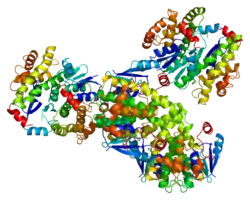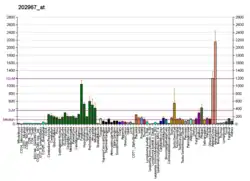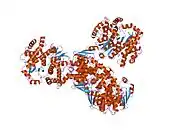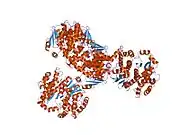| GSTA4 | |||||||||||||||||||||||||||||||||||||||||||||||||||
|---|---|---|---|---|---|---|---|---|---|---|---|---|---|---|---|---|---|---|---|---|---|---|---|---|---|---|---|---|---|---|---|---|---|---|---|---|---|---|---|---|---|---|---|---|---|---|---|---|---|---|---|
 | |||||||||||||||||||||||||||||||||||||||||||||||||||
| |||||||||||||||||||||||||||||||||||||||||||||||||||
| Identifiers | |||||||||||||||||||||||||||||||||||||||||||||||||||
| Aliases | GSTA4, GSTA4-4, GTA4, glutathione S-transferase alpha 4 | ||||||||||||||||||||||||||||||||||||||||||||||||||
| External IDs | OMIM: 605450 HomoloGene: 55585 GeneCards: GSTA4 | ||||||||||||||||||||||||||||||||||||||||||||||||||
| |||||||||||||||||||||||||||||||||||||||||||||||||||
| |||||||||||||||||||||||||||||||||||||||||||||||||||
| |||||||||||||||||||||||||||||||||||||||||||||||||||
| |||||||||||||||||||||||||||||||||||||||||||||||||||
| Wikidata | |||||||||||||||||||||||||||||||||||||||||||||||||||
| |||||||||||||||||||||||||||||||||||||||||||||||||||
Glutathione S-transferase A4, also known as GSTA4, is an enzyme which in humans is encoded by the GSTA4 gene.[3][4][5]
Function
Cytosolic and membrane-bound forms of glutathione S-transferase are encoded by two distinct supergene families. These enzymes are involved in cellular defense against toxic, carcinogenic, and pharmacologically active electrophilic compounds. At present, eight distinct classes of the soluble cytoplasmic mammalian glutathione S-transferases have been identified: alpha, kappa, mu, omega, pi, sigma, theta and zeta. This gene encodes a glutathione S-transferase belonging to the alpha class. The alpha class genes, which are located in a cluster on chromosome 6, are highly related and encode enzymes with glutathione peroxidase activity that function in the detoxification of lipid peroxidation products.[3]
GSTA4 shows very high activity with reactive carbonyl compounds such as alk-2-enals.[4] GSTA4 is highly effective in catalyzing the conjugate addition of reduced glutathione to 4-hydroxynonenal, an important product of peroxidative degradation of arachidonic acid and a commonly used biomarker for oxidative damage in tissue.[5]
Clinical significance
Reactive electrophiles produced by oxidative metabolism have been linked to a number of degenerative diseases including Parkinson's disease, Alzheimer's disease, cataract formation, and atherosclerosis hence reduced expression of the GSTA4 enzyme may have pathophysiological consequences.[3] The expression of this gene is decreased drastically among burn and trauma victims.
References
- 1 2 3 GRCh38: Ensembl release 89: ENSG00000170899 - Ensembl, May 2017
- ↑ "Human PubMed Reference:". National Center for Biotechnology Information, U.S. National Library of Medicine.
- 1 2 3 "Entrez Gene: GSTA4 glutathione S-transferase A4".
- 1 2 Board PG (March 1998). "Identification of cDNAs encoding two human alpha class glutathione transferases (GSTA3 and GSTA4) and the heterologous expression of GSTA4-4". Biochem. J. 330 (Pt 2): 827–31. doi:10.1042/bj3300827. PMC 1219212. PMID 9480897.
- 1 2 Hubatsch I, Ridderström M, Mannervik B (February 1998). "Human glutathione transferase A4-4: an alpha class enzyme with high catalytic efficiency in the conjugation of 4-hydroxynonenal and other genotoxic products of lipid peroxidation". Biochem. J. 330 (Pt 1): 175–9. doi:10.1042/bj3300175. PMC 1219124. PMID 9461507.
Further reading
- Ketterer B (2001). "A bird's eye view of the glutathione transferase field". Chem. Biol. Interact. 138 (1): 27–42. doi:10.1016/S0009-2797(01)00277-0. PMID 11640913.
- Hubatsch I, Ridderström M, Mannervik B (1998). "Human glutathione transferase A4-4: an alpha class enzyme with high catalytic efficiency in the conjugation of 4-hydroxynonenal and other genotoxic products of lipid peroxidation". Biochem. J. 330 (Pt 1): 175–9. doi:10.1042/bj3300175. PMC 1219124. PMID 9461507.
- Board PG (1998). "Identification of cDNAs encoding two human alpha class glutathione transferases (GSTA3 and GSTA4) and the heterologous expression of GSTA4-4". Biochem. J. 330 (Pt 2): 827–31. doi:10.1042/bj3300827. PMC 1219212. PMID 9480897.
- Liu S, Stoesz SP, Pickett CB (1998). "Identification of a novel human glutathione S-transferase using bioinformatics". Arch. Biochem. Biophys. 352 (2): 306–13. doi:10.1006/abbi.1998.0608. PMID 9587421.
- Desmots F, Rauch C, Henry C, et al. (1999). "Genomic organization, 5'-flanking region and chromosomal localization of the human glutathione transferase A4 gene". Biochem. J. 336 (Pt 2): 437–42. doi:10.1042/bj3360437. PMC 1219889. PMID 9820822.
- Bruns CM, Hubatsch I, Ridderström M, et al. (1999). "Human glutathione transferase A4-4 crystal structures and mutagenesis reveal the basis of high catalytic efficiency with toxic lipid peroxidation products". J. Mol. Biol. 288 (3): 427–39. doi:10.1006/jmbi.1999.2697. PMID 10329152.
- Gardner JL, Gallagher EP (2001). "Development of a peptide antibody specific to human glutathione S-transferase alpha 4-4 (hGSTA4-4) reveals preferential localization in human liver mitochondria". Arch. Biochem. Biophys. 390 (1): 19–27. doi:10.1006/abbi.2001.2352. PMID 11368510.
- Nilsson LO, Mannervik B (2001). "Improved heterologous expression of human glutathione transferase A4-4 by random silent mutagenesis of codons in the 5' region". Biochim. Biophys. Acta. 1528 (2–3): 101–6. doi:10.1016/s0304-4165(01)00177-5. PMID 11687296.
- Desmots F, Rissel M, Loyer P, et al. (2002). "Immunohistological analysis of glutathione transferase A4 distribution in several human tissues using a specific polyclonal antibody". J. Histochem. Cytochem. 49 (12): 1573–80. doi:10.1177/002215540104901211. PMID 11724905. S2CID 3114685.
- Gustafsson A, Nilsson LO, Mannervik B (2002). "Hybridization of alpha class subunits generating a functional glutathione transferase A1-4 heterodimer". J. Mol. Biol. 316 (2): 395–406. doi:10.1006/jmbi.2001.5345. PMID 11851347.
- Desmots F, Rissel M, Gilot D, et al. (2002). "Pro-inflammatory cytokines tumor necrosis factor alpha and interleukin-6 and survival factor epidermal growth factor positively regulate the murine GSTA4 enzyme in hepatocytes". J. Biol. Chem. 277 (20): 17892–900. doi:10.1074/jbc.M112351200. PMID 11884396.
- Gallagher EP, Gardner JL (2002). "Comparative expression of two alpha class glutathione S-transferases in human adult and prenatal liver tissues". Biochem. Pharmacol. 63 (11): 2025–36. doi:10.1016/S0006-2952(02)01017-1. PMID 12093480.
- Strausberg RL, Feingold EA, Grouse LH, et al. (2003). "Generation and initial analysis of more than 15,000 full-length human and mouse cDNA sequences". Proc. Natl. Acad. Sci. U.S.A. 99 (26): 16899–903. Bibcode:2002PNAS...9916899M. doi:10.1073/pnas.242603899. PMC 139241. PMID 12477932.
- Mungall AJ, Palmer SA, Sims SK, et al. (2003). "The DNA sequence and analysis of human chromosome 6". Nature. 425 (6960): 805–11. Bibcode:2003Natur.425..805M. doi:10.1038/nature02055. PMID 14574404.
- Ota T, Suzuki Y, Nishikawa T, et al. (2004). "Complete sequencing and characterization of 21,243 full-length human cDNAs". Nat. Genet. 36 (1): 40–5. doi:10.1038/ng1285. PMID 14702039.
- Engle MR, Singh SP, Czernik PJ, et al. (2004). "Physiological role of mGSTA4-4, a glutathione S-transferase metabolizing 4-hydroxynonenal: generation and analysis of mGsta4 null mouse". Toxicol. Appl. Pharmacol. 194 (3): 296–308. doi:10.1016/j.taap.2003.10.001. PMID 14761685.
- Gerhard DS, Wagner L, Feingold EA, et al. (2004). "The Status, Quality, and Expansion of the NIH Full-Length cDNA Project: The Mammalian Gene Collection (MGC)". Genome Res. 14 (10B): 2121–7. doi:10.1101/gr.2596504. PMC 528928. PMID 15489334.
- Patrick B, Li J, Jeyabal PV, et al. (2005). "Depletion of 4-hydroxynonenal in hGSTA4-transfected HLE B-3 cells results in profound changes in gene expression". Biochem. Biophys. Res. Commun. 334 (2): 425–32. doi:10.1016/j.bbrc.2005.06.099. PMID 16005854.
- Coppedè F, Armani C, Bidia DD, et al. (2005). "Molecular implications of the human glutathione transferase A-4 gene (hGSTA4) polymorphisms in neurodegenerative diseases". Mutat. Res. 579 (1–2): 107–14. doi:10.1016/j.mrfmmm.2005.02.020. PMID 16054170.




